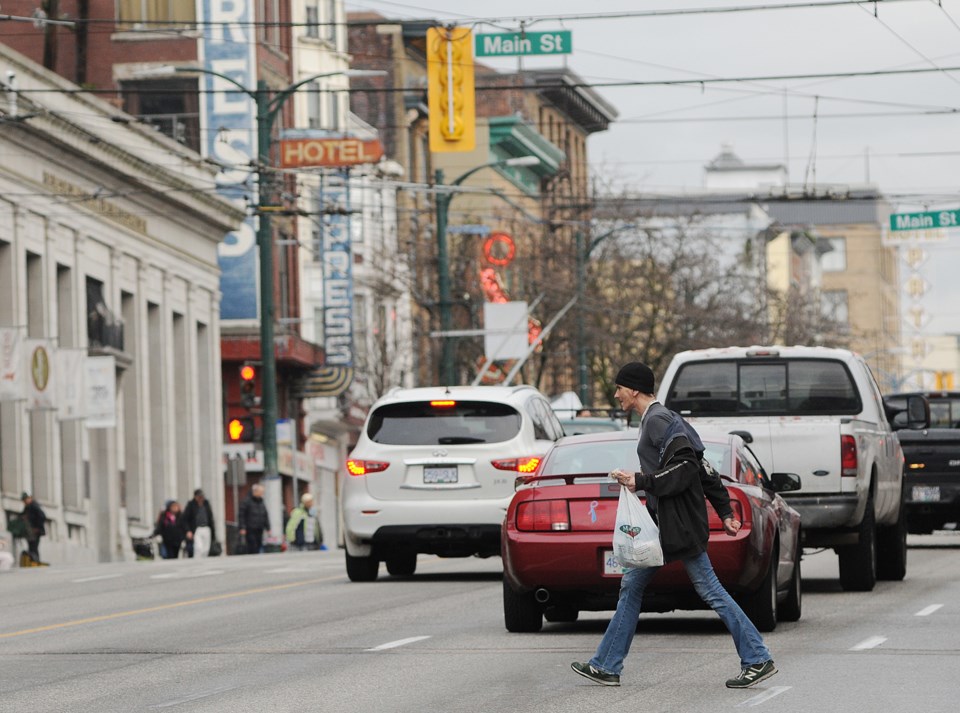The ticketing of Downtown Eastside residents for jaywalking has dropped dramatically since police launched a blitz in 2008 and the practice has reached its lowest point in seven years.
A Vancouver Police Department report going before the Vancouver Police Board Thursday says an average of 17 jaywalking tickets per month was issued in the Downtown Eastside in 2013.
That average, which further dropped to nine per month in the last half of 2013, is down from a high of 83 per month in 2008 when police launched a ticketing blitz that targeted jaywalkers. In 2007, police handed out an average of 39 tickets per month, 20 in 2009, 23 in 2010, 35 in 2011 and 22 in 2012.
The drop in tickets comes despite the Downtown Eastside still being a dangerous area in the city for injuries and fatalities for pedestrians.
The report shows that 189 pedestrians between 2002 and 2012 either died or were injured in the Downtown Eastside after being struck by a vehicle.
The highest number of incidents — 26 — occurred in 2007, the year prior to police launching the blitz in 2008. In the year of the blitz, police recorded 25 injuries or fatalities, dropping to 15 in 2009 and then a surge to 24 in both 2010 and 2011. Incidents dropped again to 16 in 2012.
The report pointed out a person is eight times more likely to be struck by a vehicle in the Downtown Eastside that in the whole of downtown.
The report is in response to B.C. Police Complaint Commissioner Stan Lowe’s request for a more “meaningful comparison” of statistics on jaywalking and the number of pedestrians struck in the Downtown Eastside.
Lowe made the request in November after being dissatisfied with the police board’s decision to dismiss a complaint from Pivot Legal Society and the Vancouver Area Network of Drug Users that accused officers of unfairly targeting and ticketing Downtown Eastside residents.
Pivot obtained statistics from the police department via the Freedom of Information Act that revealed 76 per cent of 2,699 jaywalking tickets issued in the city between 2008 and 2012 were to people in the Downtown Eastside.
Another 17 per cent were issued in downtown while none was handed out in Shaughnessy, Point Grey, Oakridge, Marpole, Killarney and several other neighbourhoods in the city.
The police board ordered the police department to investigate the complaint. The board dismissed the complaint in September, saying ticketing was done to change behaviour and reduce injuries and fatalities.
Pivot appealed the decision with Lowe, who recommended the police board also implement a policy to ensure the number of tickets issued by police for minor offences such as jaywalking does not prevent vulnerable residents from seeking police protection.
As pointed out by Wally Oppal when he was commissioner of the Missing Women Commission of Inquiry, the concern was residents, particularly vulnerable women, would not seek out police when in danger for fear of being arrested for not paying a bylaw ticket.
But the VPD report said it was “a widely spread misconception” that police officers can arrest someone for unpaid bylaw tickets where a warrant does not exist.
“The police do not have the ability to arrest for breaching a bylaw or failure to pay a fine,” the report said.
In 2012, police issued 46 jaywalking tickets to women in the Downtown Eastside. That number dropped to 26 last year, with the last ticket to a woman in the neighbourhood issued Aug. 7, 2013, said the report, noting the challenge of policing the area.
“The lines between social issues, health issues and criminal behaviour are blurred and at times cannot be completely disentangled,” the report said. “Police officers working in the [Downtown Eastside] use their discretion to navigate and balance the requirements of the law, public interest and the safety and well-being of the person before them.”
Since the ticketing blitz in 2008, the City of Vancouver has lowered the speed limit to 30 km/h along a stretch of East Hastings, added countdown timers at crosswalks, improved lighting at intersections and installed a mid-block crosswalk just west of Main and Hastings.
mhowell@vancourier.com
twitter.com/Howellings



